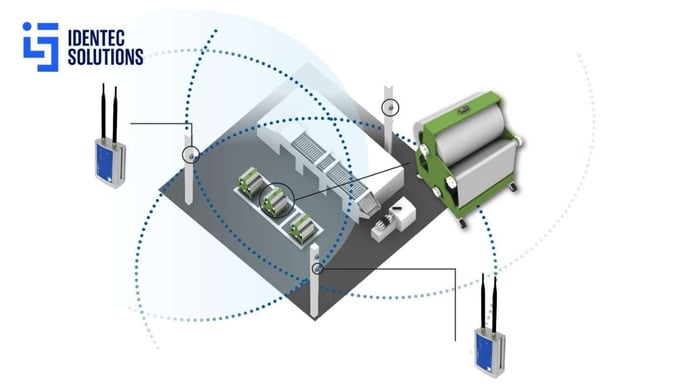Auto Identification Technology: AIDC and Asset Agent
| Written by Mark Buzinkay

No video selected
Select a video type in the sidebar.
Auto Identification Technology and Material Handling
A Material Handling System (MHS) is a set of equipment that makes physical movement within the distribution chain possible. This includes the production chain and the warehouse, for example, raw materials, work in progress, and finished goods. Thus, such systems perform a wide range of activities that are necessary to move a load around the factory floor as well as store and freight it.
In today's hyper-changing industry, new MHS technology is vital. In the United States alone, there are approximately 3,624 businesses operating in the Material Handling Equipment Distributors sector as of 2024. (2) However, updating the systems in brownfield plants can be challenging, and it is not abnormal to find material handling approaches that are not working in the right conditions.
One of the current limitations that Material Handling Systems face is information visibility. Information visibility involves access to information from different parts of the supply chain and, more specifically, by Material Handling Systems. It also deals with relevant and real-time data for handling in the information system.
The increasing need for real-time information at all phases of the supply chain has a significant limitation on the control systems within materials handling operations. From a pragmatic point of view, more control systems and software must be in place to direct the automated materials handling equipment that moves inventory through a facility. Furthermore, such systems must be able to manage all status data of each item at all times - in real-time.
In comparison, supply chain management already achieved the integration of business processes among trading partners - to take time, inventory and unpredictability out of the supply chain. Regardless, the movement of goods through the supply chain begins at the factory and warehouse levels.
As warehouse management systems (WMS) already monitor the processes as they are completed, the next step is tracking inventory between the steps within the facility: the movement of assets and materials is being monitored at the level of the conveyors, sorters, containers and palletisers.
How does Auto Identification Technology help with Production?
Auto Identification is an established technology that changes the world by merging bits and pieces to form one seamless, real-time network interacting with the real world. Production cells profit from the more powerful ways to identify products and access significant information in an automated way. There are numerous reports on how companies benefit from the use of AIDC, supporting more intelligent automation and control in the factory. For example, intelligent software agents make distributed decisions or co-operatively schedule their activities. The information needed to make such decisions must be accurate, timely, and structured: AIDC delivers the supporting infrastructure in a scaleable and seamless manner.
With RFID-based AIDC, the tag's location within the pallet or product will not impact the layout of the production cells. Additionally, products in conveyors will not be required to turn in order to identify them. Finally, there will be no need for multiple barcode / QR code tags on a product.
At the same time, automated production cells get access to more relevant information for handling and become truly flexible, as they will automatically reprogram themselves to manage different products using information, such as the product size and specific tasks to be performed in them. Therefore, the AIDC software can automatically notify those devices of the nature of the incoming product.
Learn more about automatic identification system transponder
Auto Identification Technology: Asset Agent
In linking AIDC with the concept of intelligent products, we get the most powerful tool for controlling production. A production cell in need of material can now contact the holon associated with that material/product to decide how and from where the material can be obtained. Asset Agent is such a provider of auto-identification.
For example, as all the loading cells are busy, the resource holon will decide to acquire and transport a specific box of green tires to the cell using a suitable rubber carrier. Holon's work is directly influenced by the information associated with each rubber material container. Eventually, a pick-by-light signal will emerge, and the worker will select the correct rubber material container to be pulled to the production cell. The production cell immediately identifies the carrier automatically and checks the conformity with the order. If correct, the production cell accepts the container (see also: pick by light system); if not, it won't allow the material to be used in the production process.
New customer trends are generating substantial demand for customisation of products, while delivery times must be met or even shortened. While enhancements in the flexibility and speed of the supply chain lead to significant stock reductions and productivity improvement, companies are using this extra capacity to increase the range of their products. The ongoing pressure to improve efficiency and maintain flexibility is answered by solutions like Asset Agent, optimising existing brownfield MHS.
Having more items with less stock of each one places a considerable strain on the manufacturing chain. As the range of offered products increases, there is the need to perform last-minute changes. These changes are everywhere in the manufacturing chain and may go from mixed packing to product finishing. Sensitive materials must be handled in a time-conscious manner to avoid (valuable) waste. Thus, the process output at the warehouse steadily increases while the overall process time decreases dramatically.
The only way to cope with this challenge is to automate as many material handling operations as possible. Products must be automatically routed from storage to the finishing, picking and packing cells. MHS takes advantage of solutions like Asset Agent, adding AIDC, pick-by-light and sometimes real-time location (RTLS tags) to their arsenal of creating an information-based MHS.
FAQs
What is Auto Identification Technology (AIDC), and how does it integrate with Computer Integrated Manufacturing (CIM)?
AIDC refers to technologies that automatically identify items, collect data about them, and enter that data directly into computer systems without human involvement. In the context of CIM, AIDC technologies such as barcode and radio frequency identification (RFID) play a crucial role. They enable a seamless and adjustable flow of information, capturing the processes for each task in the manufacturing environment. This integration ensures timely and accurate data availability, which is crucial for efficient resource utilisation and value addition in the production process.
How does AIDC technology contribute to Material Handling Systems (MHS) and supply chain management?
AIDC technology significantly enhances the efficiency of Material Handling Systems by providing real-time information visibility across different parts of the supply chain. This involves tracking inventory, monitoring the movement of materials, and managing the status of each item. By automating these aspects, AIDC helps MHS in controlling the movement of inventory more efficiently, thereby reducing unpredictability and improving overall supply chain management. This leads to better control systems, reduced inventory levels, and enhanced productivity. A great example is car logistics.
What is the role of the Asset Agent in the context of AIDC, and how does it support manufacturing processes?
Asset Agent's AIDC technology is a powerful tool for controlling production processes. It facilitates intelligent decision-making about material procurement and transportation within a manufacturing setup. For instance, in a scenario where different production cells require specific materials, Asset Agent can efficiently identify the most suitable way to acquire and transport materials. This system supports customisation demands, optimises material handling operations, and enhances the flexibility of manufacturing processes, thereby accommodating last-minute changes and reducing waste through timely and efficient material management.
Takeaway
The integration of Auto Identification Technology (AIDC) in manufacturing and material handling systems signifies a pivotal advancement in the realm of industrial efficiency and precision. The seamless incorporation of AIDC with MHS ensures that vital information is accurately and promptly available, optimising the use of resources and adding economic value to products. Asset Agent emerges as a crucial component, revolutionising how materials are managed and manoeuvred within production environments. It enables smarter decision-making, enhances flexibility, and supports the increasing demand for product customisation while maintaining efficiency. This technology not only streamlines operations but also propels companies towards future-ready manufacturing practices. To explore how Asset Agent can transform your manufacturing and material handling processes, we invite you to download our comprehensive brochure. Discover the full potential of Asset Agent modules and take the first step towards an innovative, efficient future in manufacturing.
Delve deeper into one of our core topics: Real time location systems
Glossary
Warehouse Management Systems (WMS) are software solutions that optimize warehouse operations, including inventory tracking, order fulfillment, and logistics. They enhance efficiency by automating tasks like stock replenishment, real-time data collection, and labor management. WMS integrates with enterprise resource planning (ERP) and supply chain systems to improve accuracy, reduce costs, and accelerate order processing. Modern WMS utilizes AI and IoT for smarter decision-making and warehouse automation. (3)
Sources:
(1) Hodgson, S., Nabhani, F. and Zarei, S. (2010), "AIDC feasibility within a manufacturing SME", Assembly Automation, Vol. 30 No. 2, pp. 109-116. https://doi.org/10.1108/01445151011029736
(2) https://www.ibisworld.com/united-states/industry/material-handling-equipment-distributors/5518/
(3) Richards, G. (2021). Warehouse Management: A Complete Guide to Improving Efficiency and Minimizing Costs in the Modern Warehouse (3rd ed.). Kogan Page.
Note: This article was updated on the 13th of February 2025

Author
Mark Buzinkay, Head of Marketing
Mark Buzinkay holds a PhD in Virtual Anthropology, a Master in Business Administration (Telecommunications Mgmt), a Master of Science in Information Management and a Master of Arts in History, Sociology and Philosophy. Mark spent most of his professional career developing and creating business ideas - from a marketing, organisational and process point of view. He is fascinated by the digital transformation of industries, especially manufacturing and logistics. Mark writes mainly about Industry 4.0, maritime logistics, process and change management, innovations onshore and offshore, and the digital transformation in general.



